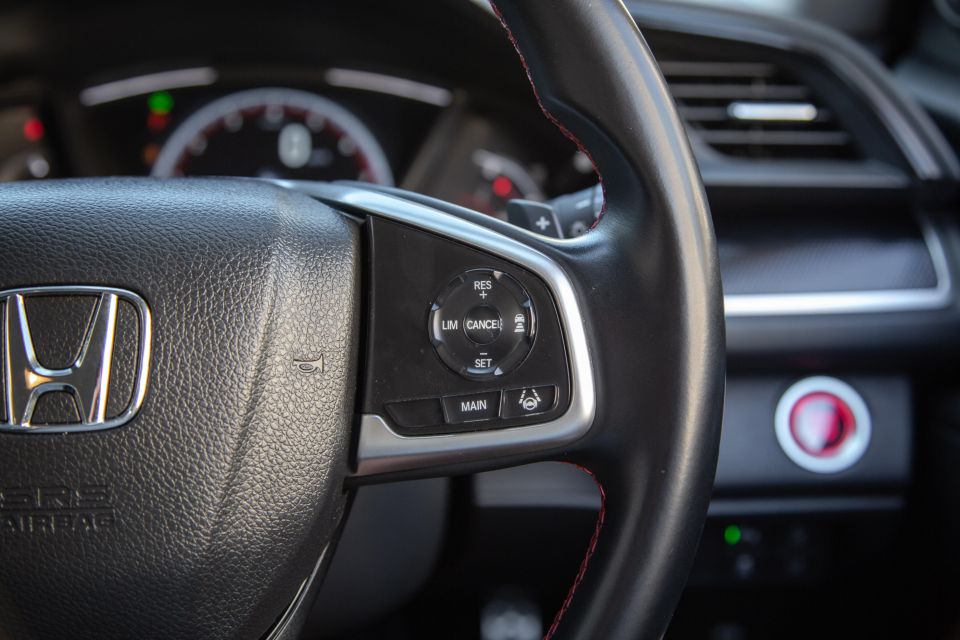

Max Davies
2026 Ram 1500 Rebel review
6 Days Ago
It’s smart looking and well rounded, but why should you consider the four-door sedan version of the Honda Civic RS over its hatchback twin?



Journalist
New from
$22,390
excl. on-roads

Journalist
New from
$22,390
excl. on-roads


Journalist
New from
$22,390
excl. on-roads

Journalist
New from
$22,390
excl. on-roads
Quickly see how this car stacks up against its competition. Select any benchmark to see more details.
Where expert car reviews meet expert car buying – CarExpert gives you trusted advice, personalised service and real savings on your next new car.
It’s great that Honda mirrors its current mainline five-variant-strong Civic hatchback range with a sedan alternative. You’ve got to love choice. But are there worthy reasons why you’d opt for a four-door version when you can have a fiver instead? Because, well, more is more right?
We recently had the Civic RS Hatch, in matching Phoenix Orange Pearlescent paintwork and grey wheels, through the CarExpert garage. And convention, more than anything, suggests that a sporty RS-style makeover is perhaps better suited the five-door format. Besides, ‘warm sedan’ just doesn’t have a ring to it…
Spoiler alert: the RS Hatch was a decent 7.6-out-of-ten machine, let down mostly by a lacklustre powertrain.
You could be forgiven, at first look, thinking that the RS Sedan reviewed here is the same car. But more than a cursory glance reveals distinctly different in exterior styling, so it’s fair to presume differences between the Thai-built twins extends beyond their skins, too.

So why would you opt for the sedan RS?
For a start, its styling is a little more subtle and arguably more handsome. It’s perhaps the best looking Civic Honda currently makes.
That’s highly subjective, I know, but the four-door is slimmer in profile with less bulk along its rear screen, it has a neater and more elongated front-end styling with lighter and less fussy at the rear. You lose the showy central twin exhaust outlets with the sedan but, for some, taming the boy-/girl-racer vibe isn’t necessarily a downgrade.
In fact, the four-door’s neater tail end brings with it gets a vastly larger boot space of 517 litres against the five-door’s 340 litres.
Then there’s pricing. Opting for the RS Sedan version saves $700 on list pricing against the RS Hatch though, since Civic’s last key update in 2019, pricing for the range has been creeping upwards with some regularity.

When last we checked, the Civic RS Sedan listed for $33,340 before on-road costs. That’s a $500 hike over its Q2 2020 list price of $32,840, which itself was a $850 rise over MY19’s $31,990 before on-roads. (The RS Hatch is now from $34,040, up front when we tested it in July).
If there’s one consolation to the upward-spiraling pricing it’s that premium paint, once a $575-$650 option, is now a no-cost extra. There are seven non-standard metallic and pearlescent hues to choose from outside of the standard solid white.
Bar paintwork, there are no options. The MY19 update brought with it the Honda Sensing suite of features to RS so there’s no longer a hole needing to be filled in the active safety department.

There are loads of sporty ‘warm’ options in the small-car segment, key competition exclusively offering four-doors includes Hyundai Elantra Sport Premium (from $32,060), Kia Cerato GT (from $33,490), Mazda 3 G25 GT (from $34,090), Subaru Impreza 2.0i-S (from $31,160) and Toyota Corolla ZR (from $34,195).
So while the Civic RS wants for decent coin, it doesn’t appear too overly priced against other logical sedan options.
Closer to home, the RS is a fair jump up from the identically powered 1.5-litre turbo and CVT-equipped VTi-L (from $28,690) and a touch over a grand more affordable than the more luxurious and comfort-leaning VTi-LX flagship (from $34,390).



Buy your new car without the stress. It's fast, simple and completely free.

Great service from Travis and team, second time I have used this business would not hesitate to recommend them to anyone
Craig C.
Purchased a Ford Ranger in Sunshine Coast, QLD
CarExpert helped Craig save $7,224 on his Ford Ranger, now let us save you on your next new car.
Get your BEST priceBlack-detailed RS styling with grey 18-inch alloys shod with quality Michelin Pilot Sport 4s kicks off the exterior, which also features LED lighting front and rear, auto-leveling headlights, rain-sensing wipers, power-folding mirrors and front and rear sensors.
Given the price hike over the mechanically similar VTi-L, the RS adds inclusions such as leather-appointed seating, an eight-way electric driver’s seat with heating for both front pews, a leather-trimmed paddle-shift wheel and gear knob, alloy pedals, dual-zone climate control and DAB+ in tandem with 452-watt 10-speaker audio. Cruise control is adaptive, too.
Apple CarPlay and Android Auto mirroring is featured though there’s no proprietary sat-nav, while the guided reversing camera is augmented by Honda’s nifty LaneWatch kerb-side camera system. Like the rest of the range, the RS fits a large LCD driver’s instrumentation screen.

Civic’s most recent 2019 update introduced Honda Sensing as standard fitment to RS boosting its active safety credentials significantly. The suite brings with it AEB with forward collision warning, both lane departure warning and lane keeping, as well the aforementioned high-beam support and adaptive cruise control.
The Civic sedan range scored a five-star ANCAP rating in 2017 based on both domestic and ASEAN NCAP testing that year. Though listed separately on the program’s website, both the sedan and hatch share identical 34.68 out of 37 scoring because, well, the assessment was conducted on the former and results were applied to the latter.
As covered in our hatch review, the 2017 testing predates AEB performance assessment though the Civic acquitted itself well across the board, with 14.75 out of 16 for frontal offset, 14.93 for side impact, 2 out 2 for pole testing and ‘good’ for whiplash and pedestrian protection.

Civic cabins have long been an area of strength, a combination of a remarkable amount of roominess and funky, unmistakably Japanese design. And the leather-appointed, red-stitched RS treatment serves it well.
The presentation as a measure of value more impressive, perhaps, in lower-grade variants than it is here in pricier RS, where some of the material choice is a bit low-rent for this price point and where the styling is now, in this generation’s maturity, starting to show its age. While the look and feel mightn’t be to all tastes, the RS touches bring a nice sense of sporty celebration.



The front seats can be set very low to taste though raising them to much higher than their lowest level doesn’t mess with ergonomics and control placement too badly. The shapeliness and support of the seating, front and in the hugely roomy row two, is exceptional. For four-adult long-haul comfort in its small-car segment, the Civic really is a hard act to top.
Improvements were introduced to the 7.0-inch touchscreen system not long ago but, frankly, the graphics, format and sometimes slow and clumsy user interface are all past their prime. Most of Civic’s competitors now offer slicker, quicker and nicer systems in high-end variants. The LCD driver’s screen, too, is overdue for a freshening up even though it remains something of a distinctive centrepiece of the cabin design.
The ‘love them or loathe them’ quirks remain. LaneWatch, as beneficial as its intent, tends to become a distracting annoyance to the point where you stop ‘watching’ it, defeating its very purpose. Once you switch it off, it reactivates at the next touch of the indicator stalk.




And that semi-hidden ‘alcove’ with dual USB ports that keeps your phone tucked away while charging, is fiddly enough to make its facility mostly redundant. There’s an HDMI port if you fancy plugging in a video source.
The Civic offers a huge console bin with USB port – presumably for the rear occupants as there’s no device power in row two – as well as a novel stackable dual-cup-holder arrangement and heaps of oddment stowage. However, the lack of rear air vents is, as in any vehicle, a fairly large oversight.
While the sedan’s commodious 517 litres of boot space trumps the five-door’s 340 litres comprehensively, it’s at the mercy of smaller boot lid and load-through apertures. It’ll fit long stuff, but it’s a bit limited for large objects once the 60:40 split-fold rear seat backs are stowed. As regular boot space goes, though, there’s a helluva lot of room to work with.

The 127kW at 5000rpm and 220Nm from just 1700rpm produced by the 1.5-litre turbocharged petrol four is quite a step up from the paltry 104kW/174Nm of the naturally-aspired 1.8-litre in low-spec Civics, and on singular merit it’s quite a lusty little engine.
Thing is, Honda hasn’t done anything to make it even slightly sportier than the identical unit in the much cheaper (to buy) VTi-L. So we pointed out in our RS Hatch review, there’s a healthier 140kW and 240Nm combination offered in CR-V and it would’ve fit the RS bill more suitably than what it’s got.
It doesn’t sound particularly sporty – put another way, a device as sharp looking as the RS Sedan perhaps deserves a bit more sonic mojo than it can muster.

There’s no manual option. And while the CVT is a fairly obedient and handy example of its breed, there’s nothing sporting about its manner or response to the fairly irrelevant paddle-shifters.
The powertrain has 1326kg to contend with, making the RS the heaviest Civic sedan variant if still impressively lightweight for its size and practical accommodation. But at 6.3L/100km for the combined claim, it’s also the thirstiest of the 1.5-turbo four-door siblings as the VTi-L and VTi-LX are said to return just 6.0L. It’s a hunch, but I’d wager the RS is also the slowest of the trio.
The good news, though, is that it’ll happily run on 91RON.

Despite the patent lack of powertrain sportiness, it’s quite refined in nature and surprisingly alert in response. Its keenness to lunge forward at the twitch of the right foot is urgent and there’s ample tractive effort backing it up to make acceleration satisfying swift.
For the around town point and stuff it’s great, never dropping the ball when you want to swiftly exit a side street or plug a gap in traffic. The CVT also mostly avoids pinning the engine in its midrange to the point of annoyance.
But dig in harder in search of higher-rpm power and the powertrain become a little flat and strained, dissuading you from chasing maximum performance. Some initial feistiness, then, without much back up in the deep end.
The Civic RS can be a satisfying punt though I’d stop short of calling it certifiable fun. There’s certainly depth in the chassis, with an impressive amount of grip thanks to those Michelins that, at 235mm wide, are 20mm broader per tyre than other variants in range.
The steering is excellent: even and concise, not too sharp off centre, with a weight that nice on the move if a little on the arduous side at low speeds. The front end offers assertive lateral grip and it points through corners with consummate accuracy and once you start carrying speed and modulating the throttle it remains balanced and surefooted.



The RS can be quite handy once you wind it up though it demands you lean on its fine chassis while coercing the powertrain. Point to point, it can cover ground at an impressive clip but it’s more capable than lively. No bad thing for some owner preferences.
The ride and handling balance, though, is really nicely struck. It’s certainly not damped overly softly yet the compliance over bumps is fantastic. It quiet and refined on the move, too, save for a bit tyre rumble across coarse surfaces at highways speeds.
Its 11.2-metre turning circle is fairly average but it’s an easy device to judge and to park. There are three angles you can choose from for the reversing camera too – ‘regular’, ‘kerb’ and ‘wide’ – though the latter is all that beneficial.

Where expert car reviews meet expert car buying – CarExpert gives you trusted advice, personalised service and real savings on your next new car.
The Civic is covered by five-year/unlimited-kilometre warranty.
Servicing requires common 12-month regularity if capped with short 10,000km intervals, with the first five visits capped at $297 per basic service, or $1485 total, not including periodic ‘adaptive’ items such as various filters and fluid that do jack the pricing up at some intervals.

Buy your new car without the stress. It's fast, simple and completely free.

Great service from Travis and team, second time I have used this business would not hesitate to recommend them to anyone
Craig C.
Purchased a Ford Ranger in Sunshine Coast, QLD
CarExpert helped Craig save $7,224 on his Ford Ranger, now let us save you on your next new car.
Get your BEST priceRelatively minor differences in pricing and practical boot space apart, buyers keen on Civic RS will ultimately lean towards the hatch or sedan on aesthetics alone. They’re otherwise interchangeable in spec and no doubt very similar in the experience: decent, nice driving and impressively practical options either way.
Neither is perhaps the first choice in ‘warm’ fun machines in segment and perhaps treated best as impressive all-rounders.
The Civic isn’t the only offering in showrooms suffering pricing creep partly due to influence beyond Honda control. But it does impact the appeal of any model line feeling its advancing age in places in the company of increasingly nicer and slicker competition asking for similar money.
Where expert car reviews meet expert car buying – CarExpert gives you trusted advice, personalised service and real savings on your next new car.


Max Davies
6 Days Ago


Max Davies
4 Days Ago


Neil Briscoe
3 Days Ago


Max Davies
2 Days Ago


James Wong
21 Hours Ago


William Stopford
19 Hours Ago